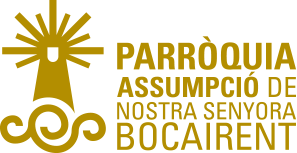500 years of history
The Parish Church, dedicated to Our Lady of the Assumption, celebrated its 500th anniversary in 2016. In this article we will provide a brief overview of Bocairent’s most emblematic building.
It is believed that there was once a castle where now the church stands. In the 16th century when Bocairent was no longer on the frontier, the castle was demolished and the Parish Church erected in its place by reusing the same masonry in the gothic style.
The gothic distribution is characterised by a wide central nave without a crossing, and side chapels located between the buttresses, which provide testimony to the layout of the primitive church. According to Martín of Viciana’s “Chronicles of the illustrious and honoured city of Valencia” “this church was consecrated by the reverend Bishop Lagaria, whilst assisting in the consecration was the famous preacher Frey Castañoli of the Order of Saint Domingo; according to the act received by the notary Genís Cerdán on 6th July MDXVI”.
Furthermore, it is known that in 1597 Saint Juan de Ribera reconsecrated the church after it was desecrated in a fight that led to bloodshed.
The beginnings
Since the reconquest the patron saint of Bocairent had been Saint James. However, at the same time, the bishop and martyr Saint Blaise was also held in great devotion in the town. This came about because the textile workers felt a certain identification towards the saint due to the combs used in his martyrdom in Sebaste, similar to those they themselves used when carding wool.
And so, when the chapels were being built beside the entrance portals to the town, a chapel to Saint Blaise was put up next to the New Door in 1587. This was also the same year when the Royal Cloth Factory was established. Whilst it is certain that Saint Blaise was named the town’s patron saint in 1632, the oldest actual reference made to the main fiestas being dedicated to Saint Blaise dates back earlier, to 1625. Many years after the laying of the foundational stone of the Communion chapel in 1665, a chapel dedicated to Saint Blaise was erected in the Parish Church around 1720. The chapel of Our Lady of the Roser was started in 1665. Thanks to a wall inscription in Latin that can be seen inside the archaeological museum we know when building work began on the chapel, and that it also took over 20 years to build. The inscription in Latin reads: “To all, the protection of the Virgin Mary awaits us. (The chapel) was erected in honour of the best of mothers, with great enthusiasm and devotion from all of the townspeople. Do not disregard our pleas. Mother: protect the pious people. (The building) started on 4th February 1665”. The stone used in the construction was extracted from the Rompegales quarry.
In 1651 the Brotherhood of Our Lady of the Roser was founded. The Brotherhood of the Minerva was instituted in 1579 as is stated in the Book of the Minerva. Both brotherhoods contributed to the building work. The chapel has always been presided over by the Tabernacle and Our Lady of the Roser. The decoration is in the imperial style: ornamentation, floral motifs, mythological figures…and was created by José Parreu well into the 18thcentury.
The building work
The part of the Parish Church comprising the central nave going up to the sculptures of Saint Peter and Saint John is baroque in style and dates from the beginning of 1700. There are chapters signed on 1st August 1700 by the elected members of the building committee and the master builders who carried out the construction work, that clearly identify them as being residents of the town. We know that the committee responsible for the building work was made up of three parts. In first place, were the main officials in charge of the tender, the judge and head of the Council, the three jurors, the administrator of weights and measures (mostasaf), and an administrator. In second place, were three priests in representation of the Parish Church clergy chapter:
mosén Gaspar Marco, doctor in theology and vice-rector, mosén Lluís Maiques, and mosén Pere Francés. There were also five citizens representing the parish: Joan Belda, of Tomàs; Joan Belda, of Pere; Dídac Galbis, of Miquel; Joaquim Maiques, and Joan Puerto, of Gregori.
The town’s master builders responsible for actually carrying out the work were: foreman Andreu Constant, foreman Josep Vanyó, foreman Vicent Llobregat, foreman Josep Castelló. The project involved the complete rebuilding of the church from the foundations up. Other foremen from the town soon joined them: for example, stone mason Josep Campos who participated in the first stages of work that lasted until the beginning of 1702, and who was in charge of the masonry, namely the main entrances and the skirting boards…. By the end of 1704 an eighth of the work had been completed. An inscription from that year can be seen on the side door.
By the autumn of 1707 the building work was well advanced when Mosén Miquel Santonja took over one of the jobs vacated due to the death of its previous incumbent, and which had remained unfilled in the intervening years due to the War of Spanish Succession. The subsequent ceremonial act that took place indicates that building work on the church was still in progress, because the event had to be held in the chapel of Our Lady of the Roser or in the Communion.
The Montesa earthquake
Construction on the church was restarted after the end of war in 1714. The baroque decoration in the central nave and the Saint Blaise chapel were carried out by the Vergara brothers, Francisco “the old” (1681-1753) and Manuel.
At the time the original gothic belltower was still standing, but following the Montesa earthquake (on 29thMarch and 2nd April 1748) it was left badly damaged after losing its upper sections. Therefore, it was replaced by the current belltower, which was erected in 1776 by the architect Carlos Stagin.
The extension
The front of the church (from the sculptures of Saint Peter and Saint Paul up to Saint Peter’s moat) came about as a result of the extension carried out between 1854 and 1860 by the architect Carlos Spain. In line with the academic style of the time it is neoclassical. It is highly probable that during this remodelling work the walls of the side chapels were opened up in order to make corridors, whilst at the same time statues were placed on top of the columns of the central nave in imitation of the church of the Saint Johns in Valencia.
It is clear to see the historical evolution of the Parish Church by looking at its layout. The first five stages and the primitive belltower belong to the gothic period, and almost certainly reflect the type of church known as ‘reconquest’, which are characterised by the concept of a very wide central nave (in contrast to traditional gothic churches which were narrow and tall) and side chapels between the buttresses.
This style of church is found throughout the Valencian region, therefore facilitating the work of Vignola in conceiving a new type of design for the Church of the Gesù in Rome. It was following the Council of Trent when a new style of church was proposed and developed. One which didn’t distract the gaze of the believer but directed it towards the celebration of the eucharist on the high altar during mass. This represented a clear break from previous years when the communion was celebrated in the different chapels of the brotherhoods and the guilds. Lastly, the final stage including the high altar, corresponds to an extension from the 19thcentury.







